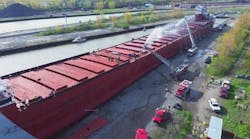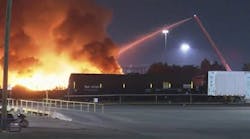Last month, we discussed using LCES (Lookouts, Communication, Escape routes and Safety zones) combined with making a fire behavior prediction to determine whether firefighters could commit to protect structures in the wildland urban interface (WUI). This month, we will explore the complex task of predicting fire behavior.
This column is intended for the firefighter who occasionally responds to wildland fires with the focus of structure protection in the WUI. The term wildland fire is used here to describe grass/brush, forest/timber or a vegetation fire.
Most professional wildland firefighters would agree that the primary factor causing firefighter burnover fatalities would be a lack of knowledge or the inability to estimate fire behavior. Or, stated another way, it is the failure to "base all actions on current and expected behavior of the fire," referring to the third of the "Ten Standard Firefighting Orders" for wildland firefighters.
Fire behavior is defined by National Wildfire Coordinating Group (NWCG) as, "The manner in which a fire reacts to the influences of fuel, weather and topography." Therefore, wildland fire behavior is dependent upon the influences of fuel bed, weather and topography. Each of the three major components has additional sub-components:
- Fuel bed — Fuel moisture, fuel loading and fuel type
- Weather — Wind, humidity and temperature
- Topography — Slope, aspect and terrain features
Each component is a study in itself. The behavior of fire can be driven by wind, fuel or topography, individually or any combination of the three.
Dr. Bret Butler is a research engineer at Missoula Fire Laboratory Center in Montana. His primary responsibility is the research of fire behavior during an out-of-control wildland fire. In the "2008 Fireline Safety Refresher" training video, Dr. Butler states that "predicting fire behavior is a most complex task…when a fire is burning in an open environment involving the three major elements of a wildfire." Yet, firefighters around the globe respond to WUI fires with little or no training in the behavior of fire, and are frequently assigned to protect structures in the path of a wind-driven wildland fire. Lack of experience, training and/or knowledge puts firefighters at a tremendous disadvantage when predicting fire behavior.
Five federal agencies have wildland firefighting responsibilities. They are the U.S. Forest Service (USFS), Bureau of Land Management (BLM), National Park Service (NPS), Bureau of Indian Affairs (BIA), and U.S. Fish and Wildlife Service (FWS). A primary responsibility of these agencies is to protect our natural resources, such as forested or chaparral/brush-covered lands. Along with some state fire agencies such as CalFire and a few local governments, wildland fire training is a priority, with the National Wildfire Coordinating Group (NWCG) fire behavior classes being mandatory. Fire behavior classes are S-190 — Introduction to Wildland Fire Behavior (an eight-hour course), S-290 — Intermediate Wildland Fire Behavior (three days), S-390 — Introduction to Wildland Fire Behavior Calculations (five days) and S-590 — Advanced Fire Behavior Interpretation (three weeks). These agencies not only have the training, but generally have a tremendous amount of wildland firefighting experience. I will refer to their personnel as professional wildland firefighters.
Professional wildland firefighters will primarily use a combination of the 10 Standard Firefighting Orders, the NWCG's Incident Response Pocket Guide (IRPG) Risk Management Process (see facing page), and the IRPG's "Look Up, Down and Around" section. The IRPG is a pocket-size guide that should be part of every wildland firefighter's personal protective equipment (PPE) and accessible for easy and frequent reference.
Let us review each of these rules or guidelines of engagement as listed in the IRPG:
Fire Behavior
1. Keep informed about weather conditions and forecasts.
2. Know what your fire is doing at all times.
3. Base all actions on current and expected behavior of fire.
The first three fire orders are intended to assist a firefighter in making a fire behavior prediction. The most difficult to understand and implement is number 3. A firefighter who has little or moderate training experience will have difficulty basing all actions on current and expected behavior of fire. Quoting a fire captain after recent burnovers, "I knew the fire was going to come out of there hard, but I didn't know it was going to come out that hard."
A fire captain on a WUI in a 2009 burnover stated, "I underestimated fire behavior by 500%." Each of these captains had over 15 years of experience with county and municipal departments that have a considerable number of WUI fires. In a recent wildland fire that resulted in numerous firefighter fatalities, the fire captain involved had nearly 20 years of experience, yet it would appear that his fire behavior prediction or estimate was underestimated by a large margin.
Fire orders continued:
Fireline Safety
4. Identify escape routes and safety zones, and make
them known.
5. Post lookouts when there is possible danger.
6. Be alert. Keep calm. Think clearly. Act decisively.
Organizational Control
7. Maintain prompt communications with your forces, your boss and adjoining forces.
8. Give clear instructions and be sure they are understood.
9. Maintain control of your forces at all times.
If you consider 1-9, then:
10. Fight fire aggressively, having provided for safety first.
The worksheet at right is one that I used as an initial-attack battalion chief to assist in making a fire behavior estimate or prediction. This may assist the firefighter who occasionally responds to a wildland fire and is assigned to structure protection/triage.
Firefighters of all ranks: This column is not intended to replace classes and training on fire behavior. Take responsibility for your training; officers, train your firefighters. Do not go to your next wildland fire without a working knowledge of fire behavior. There are many ways to increase your knowledge. Some suggestions: Study wildland fire videos such as Alan Simmons Productions and attend prescription burns and lectures. I also recommend the Campbell Prediction System by Doug Campbell (www.dougsfire.com), which uses language that we can all understand and use.
On Aug. 30, as I was preparing this column, my department, the Los Angeles County Fire Department, suffered the loss of two firefighters on the "Station Fire." Captain Ted Hall, 47, and Firefighter Specialist (engineer) Arnie Quinones, 34, were fatally injured defending their fire camp. The incident is being investigated by a joint team of Los Angeles County Fire, CalFire and the USFS. Captain Hall had 26 years of experience and Firefighter Specialist Quinones had eight years on Los Angeles County Fire. Although the investigation had just begun as of this writing, I believe one of the major contributing causes will be underestimating fire behavior.
JP HARRIS is a battalion chief (ret.) with the Los Angeles County, CA, Fire Department, where he served for 38 years. For 10 years, he trained crew supervisors and superintendents in firing operations as part of the Los Angles County Fire Department Prescription Burn Program. Harris also has taught numerous wildland firefighting classes to career and volunteer firefighters, and he created the five-volume "Wildland Video Series."





